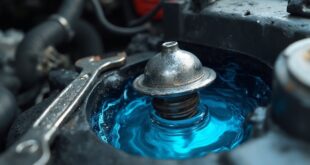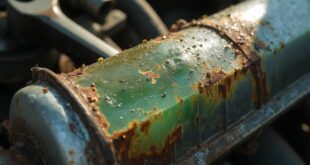To remove freeze plugs at home, first, make certain you have the right tools like a hammer, flathead screwdriver, and a specialized plug remover. Start by tapping the plug gently with the screwdriver and hammer to push it out. If that doesn't work, drill a hole in the plug for leverage. Be careful to avoid damaging the engine block during the process. With proper techniques, you'll appreciate how simple it can be to tackle this repair yourself and learn more tricks along the way.
Understanding Freeze Plugs and Their Function
Freeze plugs, often overlooked, play an essential role in your engine's health.
These cylindrical components fill passages created during manufacturing, preventing coolant leaks and protecting your engine from freezing damage. Designed to last the engine's lifetime under normal conditions, they originally worked with water but now rely on antifreeze to prevent freezing.
When coolant freezes, it expands, potentially pushing the plugs out and leading to severe engine damage. Understanding their function helps you appreciate their importance and encourages proactive maintenance.
Keeping an eye on your engine's health can save you from costly repairs down the line.
Signs of Defective Freeze Plugs
While you mightn't think about freeze plugs often, signs of their failure can manifest in noticeable ways.
If you spot coolant leaks beneath your vehicle, it's a strong indication that your freeze plugs may be defective. Pay attention to the severity of the leak; small dribbles suggest minor issues, but larger leaks could mean significant problems.
Keep in mind that replacement costs can vary widely, typically ranging from $100 to $1,000. Regular inspections can help you catch these issues early, preventing further damage to your engine and saving you money in the long run.
Methods for Removing Freeze Plugs
Removing freeze plugs can seem intimidating, but with the right methods, you can tackle the job at home. Start with the push method—gently tap a screwdriver against the plug using a hammer.
If that doesn't work, try the pry method with a special plug remover. For a more aggressive approach, drill a hole in the plug and use a screwdriver to extract it.
Alternatively, you can apply a liquid block sealer for a temporary fix. Just remember to be cautious; avoid damaging the engine block during any removal process to prevent further complications.
Tools Required for Freeze Plug Removal
To effectively remove freeze plugs, you'll need a few specific tools on hand.
Start with a hammer and a flathead screwdriver for the push method. A specialized freeze plug remover can make extraction easier and more efficient.
If you're opting for the screw method, have a drill and screws ready to create a hole for leverage. A pair of pliers can help grip stubborn plugs.
Additionally, keep a clean rag nearby to wipe away any coolant spills.
Having these tools guarantees you're prepared for the removal process and can tackle it with confidence.
Preventive Measures to Avoid Freeze Plug Issues
Taking proactive steps can greatly reduce the chances of freeze plug issues in your engine.
Here are some key measures to contemplate:
- Use proper coolant: Mix antifreeze with water as needed; avoid excess water.
- Invest in an engine block heater: This can help your engine start smoothly in colder climates.
- Perform regular maintenance: Check coolant levels and conditions routinely.
- Prepare your vehicle for winter: Verify your antifreeze is effective before the cold hits.
Frequently Asked Questions
How Often Should I Check Freeze Plugs in My Vehicle?
You should check your freeze plugs regularly, ideally during routine maintenance or at least twice a year. Keeping an eye on them helps prevent coolant leaks and potential engine damage from freeze plug failure.
Can I Drive With a Leaking Freeze Plug?
You shouldn't drive with a leaking freeze plug. It can lead to coolant loss, overheating, and potential engine damage. Address the issue promptly to avoid costly repairs and guarantee your vehicle runs smoothly.
What Materials Are Freeze Plugs Made From?
Freeze plugs are typically made from materials like steel, cast iron, or brass. You should check your vehicle's specifications to determine the exact material, as it can vary based on the engine design and manufacturer.
Are Freeze Plugs Interchangeable Between Different Engine Types?
No, freeze plugs aren't interchangeable between different engine types. Each engine has specific dimensions and designs, so you'll need to use the correct plugs for your engine to guarantee proper fit and function.
How Do I Know if My Freeze Plug Is the Right Size?
To determine if your freeze plug's the right size, measure the diameter of the existing plug or consult your vehicle's manual. Verify it matches specifications to prevent leaks and maintain engine integrity.
 Car Service Land Coupons for Oil change, Tires, Wheel alignment, Brakes, Maintenance
Car Service Land Coupons for Oil change, Tires, Wheel alignment, Brakes, Maintenance




